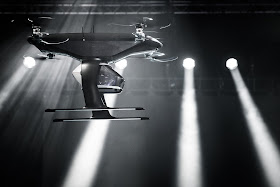Press release
- A 1:4 scale model will be performing test flights at the Amsterdam Drone Week
Moncalieri, Italy, 27 November 2018.
Italdesign performed a few minutes ago the first test flight of a 1:4 scale model of Pop.Up Next, the modular, multimodal, future mobility concept, developed in collaboration with Airbus and Audi, at the Amsterdam Drone Week, November 27 to 30.
Italdesign world-premieres Pop.Up’s first operational model, inside the exhibition’s flying arena. Once a day, until November 29, the 1:4 scale model will perform a test flight in fully autonomous mode. Capsule and ground module will simulate an on-ground trip to reach the air module; then the capsule disconnects from the ground module, connects to the air module that will fly crossing the 80 meter-length of the arena, to reach another ground module, waiting at the opposite side and then conclude the exhibition.
The main aim of the dynamic scale model is two-fold:
- To provide an objective demonstration that the project which began in 2017 with Pop.Up, and has continued this year with Pop.Up Next, is proceeding as promised and entering the next development phase. More specifically, the primary purpose of this model is to test the base functionality which will allow perfect alignment of the various modules during docking of the capsule with the drone or the ground module.
- Confirmation, strengthening and field validation of the key modularity concept, which is the core of the Pop.Up philosophy. This concept, which falls within Italdesign’s pioneering approach in the search for innovative solutions, makes the Pop.Up project unique within the world of eVTOL (electrical vertical take off & landing) vehicles being developed to meet future urban mobility requirements.
“With this project, which began with Airbus in 2017, we will demonstrate in practical terms that future mobility will no longer be a playing field for individual companies, each operating in their own specific sector, but will rather become the melting point of know-how, technologies and professional expertise from a wide range of sectors – automotive, aerospace, urban planning, social sciences – to name but a few – Jörg Astalosch, CEO of Italdesign, said. “Future mobility, is an as-yet unexplored sector which, as well as the technical challenges of developing the vehicles, will require a lot of work in the sectors of infrastructure, regulations, relations with city municipalities, services… Together with Airbus and Audi, we are convinced that our joint project, Pop.Up, made an important step to find better solutions for urban mobility in megacities”.
In keeping with its tradition as an innovative company and creator of futuristic ideas, Italdesign is taking concrete steps to deal with the problem of future urban mobility, which is already becoming relevant. To do so, it has incorporated a new Mobility Solutions division within its organisation and strategic plan, alongside with the more traditional style, engineering and vehicle-production business units, to operate with 360° approach to future mobility, smart cities and with different means of transportation. The 1:1 static model of Pop.Up Next, world-premiered at the 2018 Geneva International Motor Show, is displayed inside the exhibition as well.
AN EVENT BY AND FOR THE DRONE INDUSTRY
Amsterdam Drone Week is a co-created events festival, that unites the brightest and most creative minds of the UAS (Unmanned Aircraft System) Industry, showcases the latest technology and helps unlock the potential of drones and discovery of new applications. For the duration of one week, this umbrella event connects the entire UAS value chain through a diversity of events around drone regulations, new technology and future solutions.

























